In the Russian Arctic, One of the Most Polluted Places on Earth
It was 2 a.m. and the sun was shining, as it does day and night in mid-July in Norilsk, a Siberian city 200 miles north of the Arctic Circle.
Igor Klyushin went to the bank of the river where he used to fish with his father for grayling, a sleek and dorsal-finned beauty known for its graceful leaps above the water surface. “A very merry fish,” Klyushin recalls. “It enjoys cold and clean, clean water.”
He doubted there would be grayling here that night, but if there were, authorities had long warned it was unsafe to fish for them in the Daldykan River.
Klyushin lifted his phone and began to record video of the clay-colored muck flowing downriver from somewhere beyond a railway overpass that is a gateway to one of the largest metal mining and smelting complexes in the world. The discolored water represented “the latest environmental crime of Norilsk Nickel,” Klyushin said in the video he posted on “Norilchane” — or “Citizens of Norilsk” — the YouTube channel he helps moderate.
THE FIFTH CRIME: ECOCIDE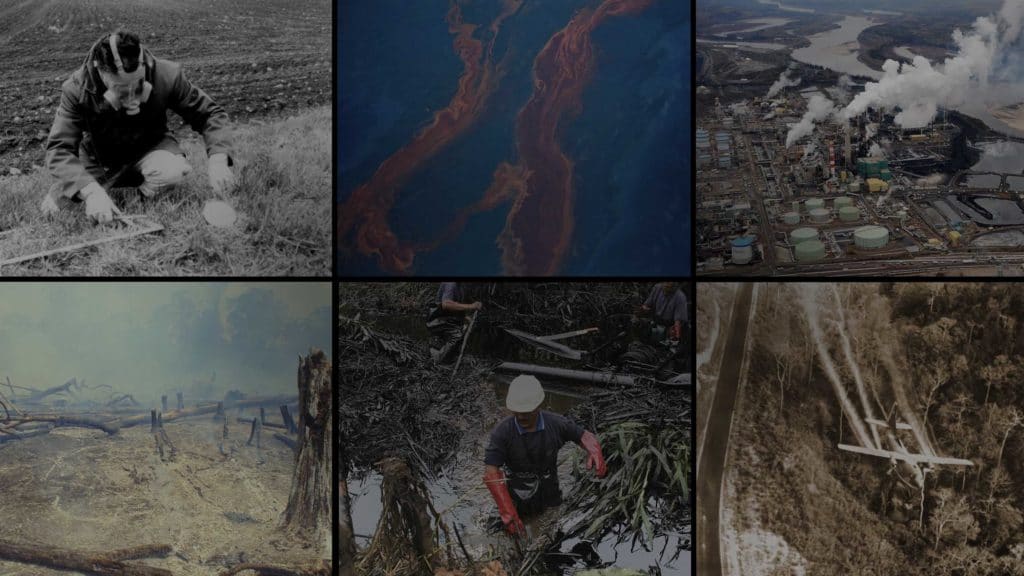 An ongoing series, produced in collaboration with Inside Climate News and NBC, about the campaign to make “ecocide” an international crime. See all stories in the series here. |
The channel and its Facebook group, which has about 8,300 members, have become action alert sites, sounding boards, and support groups for distressed citizens in Norilsk, the northernmost city in the world. The city of 176,000 has long been recognized by environmentalists — and even by the Russian Federation government — as one of the most polluted places on Earth, because of one business: Norilsk Nickel, the world’s biggest producer of palladium and high-grade nickel and a top producer of platinum, cobalt, and copper.
Originally built as a resource colony by prisoners in the Soviet Gulag, Norilsk has been a metal making center for 80 years. Norilsk Nickel outlasted communism, embraced capitalism, and now aims to ramp up production to sell the high-purity metals needed for batteries and other technologies of the 21st century clean energy economy. The company’s ambitions coincide with those of Russian President Vladimir Putin for greater development in the Far North, which he maintains can be accomplished sustainably.
But Norilsk Nickel, abetted by a lax government, has undermined its own vision for the future through actions that have spoiled a priceless environment, with implications for the entire planet. The company’s pollution has carved a barren landscape of dead and dying trees out of the taiga, or boreal forest, one of the world’s largest carbon sinks. Its wastewater has turned glacial rivers red. The acrid smoke that pours from its stacks is the worst sulfur dioxide pollution in the world. And last year, when melting permafrost beneath its giant complex gave way, a corroded holding tank burst and released 6.5 million gallons of diesel fuel into waters that flow to the Kara Sea. It was the largest oil spill in Arctic history. Although Norilsk Nickel maintains that no diesel fuel made it to the Arctic Ocean, the Russian government’s fisheries science agency told Inside Climate News that its testing showed that the contamination in fact had reached that far.
Norilsk is an example of the kind of systematic and long-term devastation that has animated a global movement to make destruction of nature an international crime. The campaign aims to treat “ecocide” in the same way as genocide or crimes against humanity, offenses that are prosecutable by the Hague-based International Criminal Court.
The process of criminalizing ecocide at the Hague would take years, and its practical effect would be uncertain, because some of the world’s biggest polluters, including Russia and the United States, are not members. A new law could not be applied to past crimes but only to future ones. But the ecocide campaign has drawn attention to the failure of existing national laws to halt severe and widespread or long-term damage that has international consequences.
Norilsk is grappling with such damage from both without and within, as part of a region that is especially vulnerable to climate change, and as a city reliant on an industry that has poisoned its land and water.
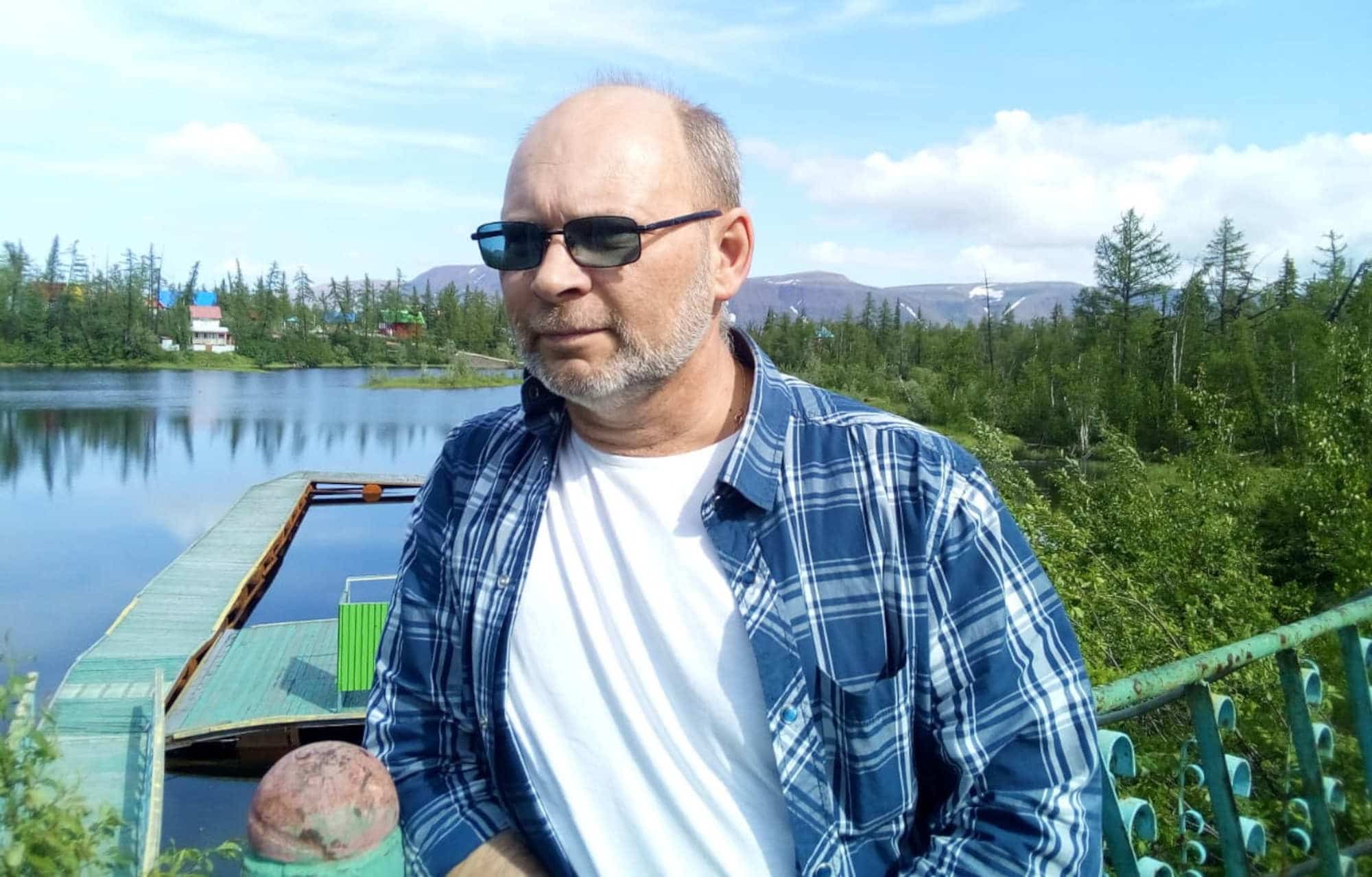
Norilsk Nickel maintains that it can rehabilitate its environment. In the wake of last year’s diesel fuel spill — which attracted worldwide attention and drew the ire of Putin — the company paid a $2 billion fine, the largest environmental penalty in the nation’s history. Norilsk Nickel has now pledged to spend more than $5 billion on pollution control and economic and social revitalization throughout the territory, Krasnoyarsk Krai.
“We do acknowledge that there are legacy issues relating to our business,” said a company spokesman, referring to the problems left over from the Soviet era. “We are implementing far-reaching measures to address them,” he said. The company approved a new environmental strategy this year with goals for addressing climate change and biodiversity and cleaning up air, water, soil, and waste.
“This will be rolled out across all of Nornickel’s operations starting from 2021, with a clear focus on generating measurable and achievable results to significantly improve the company’s environmental performance,” the spokesman said.
Local government officials express enthusiasm for Norilsk Nickel’s program, which they see as remaking the city for a new era. As the company reorients its business to serve the clean energy industry, the city and territory are planning to build new cultural attractions, a new hospital, renovated housing, and even an Arctic Museum of Modern Art. Russia anticipates that remote locations like Norilsk will become more accessible as a result of melting ice on Arctic rivers and the Northern Sea Route. Alexander Uss, the governor of Krasnoyarsk Krai, has proposed making Norilsk the official capital of the Russian Arctic.
But residents like Klyushin are skeptical, given Norilsk Nickel’s history of inaction and the pollution they’ve seen even after the company paid its fine and pledged a clean-up.
“When I came that night to see the Daldykan, my heart really sank, and it was broken,” Klyushin said, speaking by phone through an interpreter two weeks after he took video of the discolored water in July. “The river was red with pulp and the chemical smell is still in my lungs.”
The notion of building an industrial center on the tundra of the world’s northernmost continental peninsula, the Taimyr Peninsula, was staggering in its bravado. But Soviet dictator Josef Stalin viewed it as a national imperative to develop Siberia and the ore deposits discovered by explorers in the 1920s. And he could deploy an almost inexhaustible supply of workers: Gulag prisoners. Over the 20-year history of the Norilsk labor camp, until its closure in 1955, an estimated 300,000 inmates cycled through the “Norillag,” one-third of them political prisoners. At least 16,000 prisoners died: some of them were executed, but many more perished from malnutrition, disease, and the harsh conditions.
After Stalin’s regime, the Soviets kept the mining and smelting going by enticing workers with money and perks.
Klyushin’s own story illustrates why people choose to live in this remote city, where the average temperature is 15 degrees Fahrenheit (-9.6 degrees Celsius), snow covers the ground most of the year, and the total darkness of Polar Night descends in December. Klyushin came with his family as a 7-year-old boy in 1977, when his father — a metallurgist — was recruited to work at Norilsk Nickel. The Soviets viewed Norilsk as a national security asset, so it was a “closed” city with access strictly limited; to go there felt special to Klyushin.
He remembers how suddenly everything was different — fur coats and so much more food and supplies than were available in what was then the Soviet state of Kazakhstan, where they had lived before. Best of all, his father had three months of paid vacation each year. They traveled to the seaside and every other part of “the mainland,” as the country outside of Norilsk is known to those who live there. “We saw with our own eyes how the rest of Russia was,” Klyushin recalled, “and one of the indications that we were well off was that we could buy the best car that was produced in the mainland — a Volga,” a spacious, comfortable vehicle favored by state officials and celebrities.
Today life feels not quite so luxurious in Norilsk. The average monthly salary at Norilsk Nickel is still high, about $1,800, compared to the $700 monthly average across Russia. But the city is literally falling apart as the permafrost becomes increasingly unstable beneath its Soviet-made multistory buildings. No new housing has been built in the city since 2002, and many abandoned buildings stand vacant.
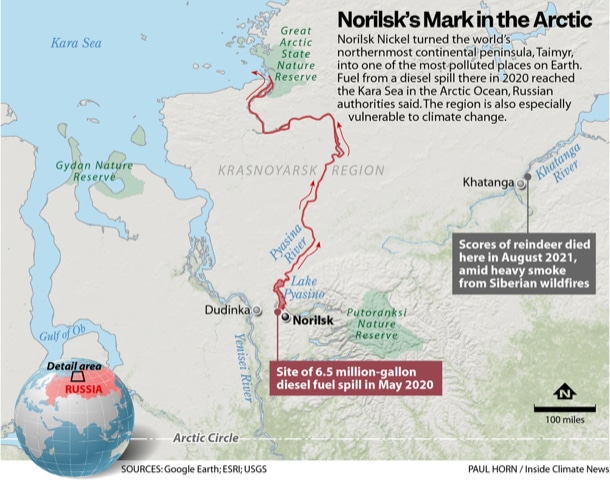
The regional news station in the nearest city, the territorial capital of Krasnoyarsk, 900 miles to the south, this summer reported on the relocation of Norilsk families from yet another five-story apartment building. It reported government data showing that 50 percent of Norilsk’s housing stock had “deformations,” and a third of the population was threatened with the loss of housing.
Norilsk’s Mayor, Dmitry Karasev, who previously worked in personnel and social policy for Norilsk Nickel, said that about 100 buildings “require special attention.” But he said the city anticipates billions of rubles from Norilsk Nickel for urban renewal, pledged this year in the aftermath of the diesel fuel spill. The company is funding a research program to assess the state of the city’s buildings.
Norilsk is part of an Arctic that is warming twice as fast as the rest of the planet, but the permafrost and structural problems cannot be attributed to climate change alone, concluded Arctic researchers at George Washington University in Washington, D.C., who have studied Norilsk extensively. Initial building design that did not fully take into account the interaction of human development and nature played a role, they wrote. So did neglect during successive waves of political and social upheaval and intensive pollution — an “aggressive corrosive environment.”
Metals mining and smelting operations tend to get more polluting over time. Valuable metals like nickel and copper make up a tiny fraction of the sulfur-rich ore and are concentrated atop rock formations. “It’s like a cake with the icing on top,” said Kwasi Ampofo, head of mining and metals research for the consulting firm BloombergNEF in London. Over the last 100 years, the concentration of copper in ore mined globally has fallen from 2 percent to 0.5 percent as companies dig deeper, according to BloombergNEF’s research. That means more ore must be smelted, generating more sulfur dioxide emissions and more tailings, and requiring more energy to produce the same amount of metal.
The story of Norilsk’s pollution is written in the trees.
It can be seen in the 5.9 million acres of dead and dying boreal forest downwind from the Norilsk Nickel compound — a scar larger than the size of New Jersey slashed into the largest forested region on Earth. A team of Russian and European scientists have looked deeper, and they have been able to track exactly when and how this corner of the forest collapsed by measuring thousands of tree ring samples, analyzing the chemical content of the wood, and examining satellite images of the canopy.
In the altered growth patterns of the spruce and larch, they have pinpointed the great rush of sulfur dioxide pollution that began in 1942, when the first nickel smelter geared up to meet the Soviet Union’s need for high-quality stainless steel during World War II.
The rate of forest dieback here jumped in the 1960s, from 5 percent annually to 30 percent annually at one study site, the researchers concluded. This coincided with the opening of large new mines that had especially sulfur-rich ore; the discovery of these metal mega-stores gave Norilsk Nickel “a new lease on life,” the company noted in its official history.
By the early 1980s, all larch trees within 40 miles east of Norilsk were dead.
The intensity of Norilsk’s pollution is detectable from space. Satellite instrument readings show that no other human enterprise — no power plant, no oil field, no other smelter complex — generates as much sulfur dioxide pollution.
In fact, the only entities on Earth that rival or surpass Norilsk’s sulfur emissions are erupting volcanoes, according to an ongoing monitoring project led by scientists at NASA and Environment Canada. In volcanoes, however, emissions die down during times of dormancy, while at Norilsk Nickel, the pollution has been steady or rising for nearly 80 years.
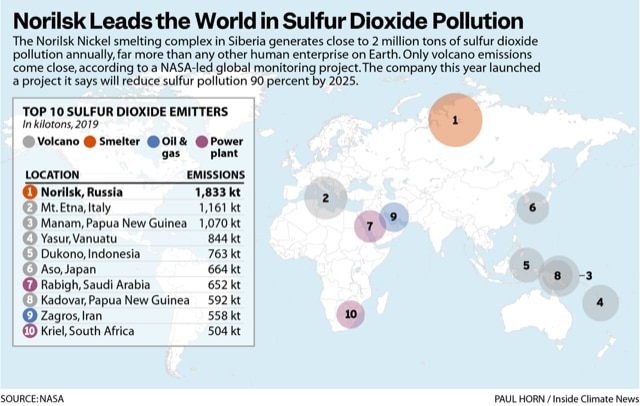
For the last 16 years, Norilsk emissions have averaged 1.9 million tons of sulfur dioxide annually, according to the NASA monitoring project. That is more than half of Russia’s sulfur pollution and equal to the total U.S. annual sulfur emissions from all sources, including industry and vehicles, all concentrated in the vicinity of a city the size of Eugene, Oregon.
“Can you imagine a huge cupola that closed the sky? That closed the whole city?” asks Valeriya “Lera” Bolgova, a leader of the Nganasan people who lives in a nearby village. In an interview, Bolgova described venturing into Norilsk on a July day this year. “It’s the first day that it’s been really, really hot in the city, and you cannot breathe. You cannot breathe there, and I was coughing all the way on the drive home,” she said. “And this all happens due to the emissions from Norilsk Nickel.”
The Nganasan are one of five Indigenous tribes of the Taimyr peninsula, who together now number about 10,000 people. The region’s first people have been unique witnesses to Norilsk Nickel’s indelible imprint on the environment, because they continue to rely so heavily on the land and water. Although their ways of life were forever altered by industrialization and government policy (the Nganasan, for example, are no longer nomadic), fish and reindeer meat are still central to their diets.
“When the pollution proceeds, and proceeds as intensively as it is nowadays, both the fish and the animals start looking for a cleaner environment,” said Bolgova. “That means going away, going away kilometer by kilometer. You have to remember that Taimyr is a very, very big area. So to find fish or reindeer for food, you have to go longer and longer distances.”
Going long distances is no small matter here. Hunters must use all-terrain vehicles on the roadless uninhabited tundra, hauling mobile huts and enough fuel and supplies to last for weeks as far as 400 miles from home.
The Taimyr reindeer, the largest herd of caribou in the world, have a range of 580,000 square miles, or more than twice the land area of Texas.
Researchers from the Siberian Federal University affirmed what Bolgova and others in the native community have perceived: that the reindeer patterns have dramatically changed on the peninsula. The scientists last year reported the startling discovery that the average stay of the reindeer at their traditional summer calving and feeding place on the coastal plains is now just 63 days, one-third of what it was in the 1960s.

But as with all the environmental problems in the Norilsk region, the reasons behind the shift are a mix of human-caused stresses, not only local pollution but climate change.
“Climate warming is here. It’s going on,” said Alexander Savchenko, head of the university’s department of resource science and conservation management, speaking on a video call through an interpreter. “And in fact, biological mass — feed for the reindeer — seems to be growing. And yet, the reindeer seem to be leaving their traditional homes,” he said.
To better understand where the deer were moving and why, Savchenko and his research team flew over the entire Taimyr Peninsula, looking out for herds. Some 370 miles northeast of Norilsk this past August, they spotted the majestic migration of 70,000 reindeer across the Khatanga River. Not long ago, such migrations occurred later, in September or October.
But the scientists also witnessed tragedy: scores of deer carcasses splayed out on the river bank. Savchenko’s team determined the cause of the deaths was the unprecedented wildfires this summer that swept through Yakutia, Russia’s largest state, to the east of Norilsk, during record heat and drought. The wildfire smoke, which blanketed Siberia and even dimmed the sky at the North Pole, reached the deer in the midst of their laborious swim through a cold river more than a mile-and-a-half wide. The reindeer turned around and swam back ashore en masse, crowding and trampling each other, with some dying of hypothermia and possibly asphyxia, Savchenko concluded.
The episode illustrates why Savchenko believes that the reindeer should be considered as much a signal species of the health of the Far North environment as the polar bear. With the location and the timing of their migration altered, the reindeer died, hemmed in by wildfire to the east and Norilsk’s pollution to the west.
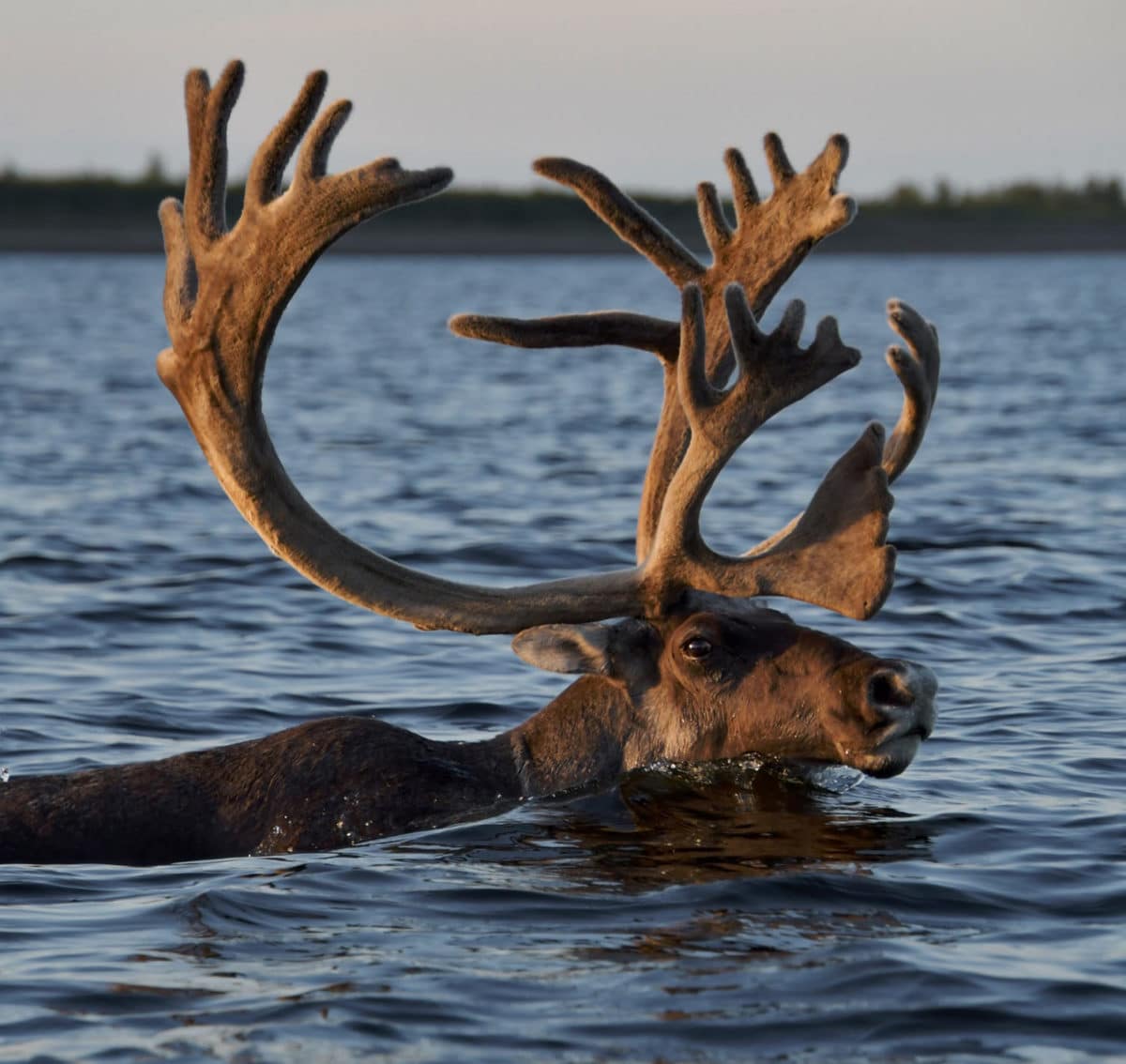
Adult male reindeer on the Khatanga River, some 370 miles northeast of Norilsk, heading for the herd’s wintering areas in August 2021 — one to two months earlier than the traditional time of migration.
Visual: P.A. Savchenko
As for human health in Norilsk, lung cancer mortality is 1.2 to 2.5 times higher here than in other Russian cities, and deaths from cardiovascular disease and infectious disease also are elevated, according to the latest study, published earlier this year by researchers at the Russian Academy of Sciences and other institutions. Such elevated rates are difficult to tie to a single source and their cause has not yet been established.
It also is difficult to study life expectancy in Norilsk because so many people retire early and move to warmer climates, where their health outcomes are not captured in the city’s statistics.
“They hope to start getting this higher pension and then go to the mainland and live this beautiful life,” said Klyushin, whose own father and uncle, who also worked at Norilsk Nickel, were among those who left. His father died a few years ago at 61 and his uncle died before he was 60. “They didn’t live long because they were poisoned by pollution,” Klyushin said.
Klyushin and other local environmental activists agitated for years for Rosprirodnadzor, the Russian environmental protection agency, to establish a presence in Norilsk.
They succeeded in early 2020, and the job of deputy head of the new Norilsk office of Rosprirodnadzor went to Vasily Ryabinin, then 39, a chemist, who as a local man had previously worked at Norilsk Nickel. While at the company, Ryabinin worked on science that he felt had a good purpose at the time: studying how to extract metals more efficiently. But he left after his beloved mentor at the company died of cancer.
Ryabinin worked for a time for another government agency, and said his friends urged him to apply for the new opening at Rosprirodnadzor, thinking he’d be well suited to the job.
Yet the warm, spring day when 6.5 million gallons of diesel fuel spilled from the Norilsk Nickel complex into the Daldykan River marked both the beginning and the end of Ryabinin’s career as an environmental enforcer for the Russian government.
In the days leading up to May 29, 2020, the temperature in the region had risen 18 degrees above normal, according to one scientific study. Permafrost had begun to give way under a corroded fuel tank at Norilsk Nickel’s power plant that Russian government safety inspectors had deemed unstable two years earlier and that the company had never fixed.
Ryabinin, who had started work 10 days earlier, received a phone call from his boss about red pollution in the river. Ryabinin’s boss went to the Norilsk Nickel plant and was denied entry, then Ryabinin joined him, and they both were turned away, with police backing up plant security guards. A man from the plant said, “This is private territory. I can’t let you in,” said Ryabinin. His boss showed his identification from the Russian environmental agency, but it didn’t help.
Ryabinin is both a mountaineer and a photographer. He grew up in Talnakh, the village adjacent to Norilsk and a place where the two worlds of the Taimyr Peninsula meet. It’s the site of some of the biggest Norilsk Nickel mines, where Ryabinin’s father once labored, and also is on the edge of a pristine landscape he loved to explore, the Putorana Plateau, a vast Siberian mountain range with thousands of untouched lakes that is a UNESCO World Heritage site.
Prevented from entering the plant, Ryabinin took his hiking boots and his camera, and with his boss, followed a nearby stream. There was no road, so they walked on foot for two kilometers to a bridge. From there, they could see “an absolute mountain river” of diesel fuel spilling into the waterways, Ryabinin said. “My boss was even afraid to actually smoke, because the smell was so strong it was possible these vapors could ignite some kind of explosion,” he added.
Ryabinin told this story in Russian in a 45-minute video posted later on the YouTube channel of Norilchane. His broadcast and the photographs he posted on Instagram were the first account that reached the outside world about the largest known oil spill ever in the Arctic. If it had occurred in the United States, it would have ranked among the nation’s top 10 spills of all time, more than half the size of the Exxon Valdez spill and six times larger than the 2010 pipeline spill of tar sands oil in the Kalamazoo River.
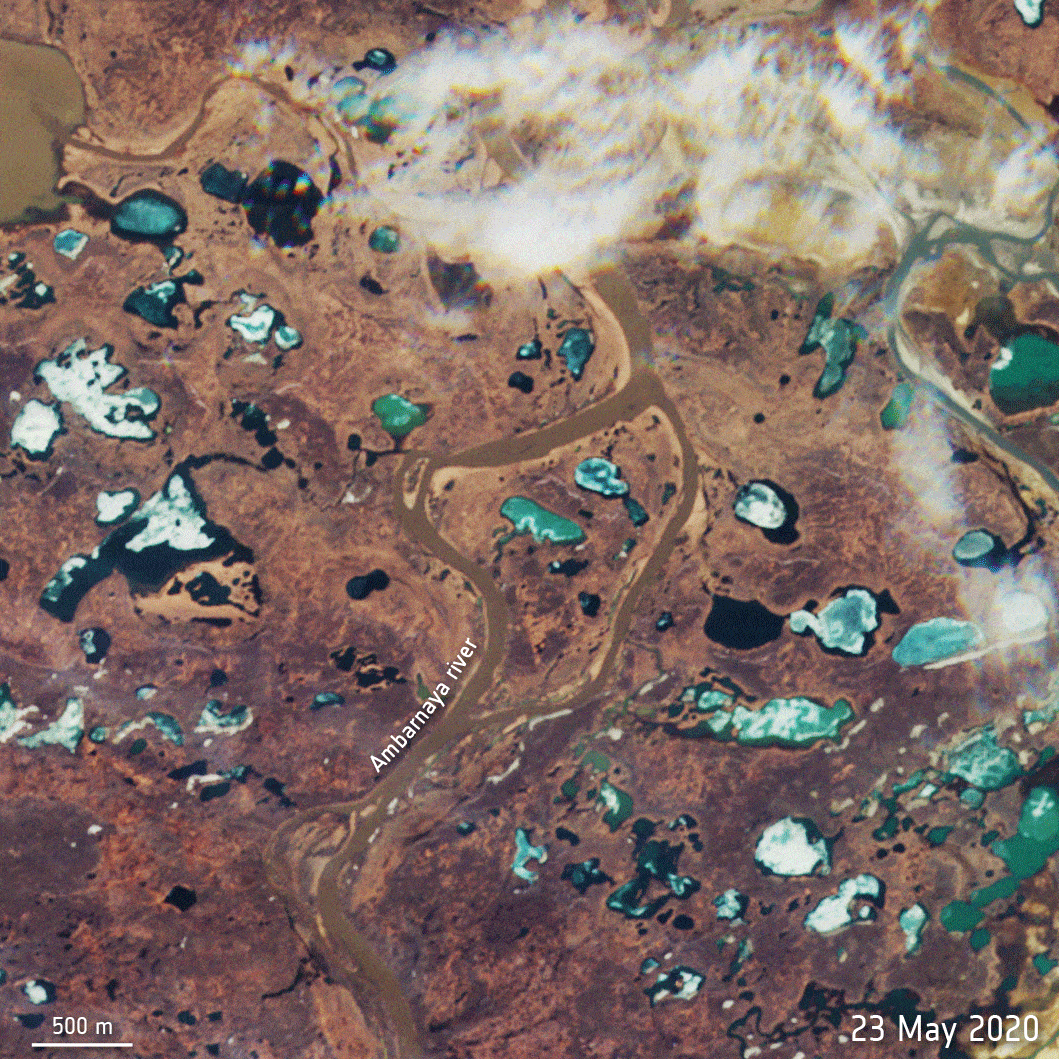
Over the next few days, top officials from the Moscow Rosprirodnadzor office flew into the city. The company deployed containment booms and hundreds of workers to clean up. But it was a harrowing week for Ryabinin, who felt the regulators were in an unwinnable race with the river’s current. He pressed to sample the water downstream in Lake Pyasino for contamination, knowing that it connects to the Arctic Ocean via the Pyasino River. His superiors told him there was no transportation available. Six days later, the head of Rosprirodnadzor, Svetlana Radionova, declared that no oil had reached Lake Pyasino. Norilsk Nickel said the same.
Ryabinin, feeling he was being prevented from determining the true extent of damage to the environment, turned in his resignation.
One of Russia’s most prominent ecologists, Evgeny Shvarts, founding director of the Center for Responsible Use of Natural Resources at the Russian Academy of Sciences’ Institute for Geography in Moscow, said he is convinced from long experience as an environmental advocate in Russia that citizens can’t rely on the government for environmental protection.
Shvarts is familiar with the spill and Norilsk Nickel’s other environmental issues. He was director of conservation policy for WWF Russia for 21 years, and in 2018 was awarded the title Honored Ecologist of the Russian Federation — the equivalent of a Presidential or Congressional Medal in the United States. Since leaving the World Wide Fund for Nature in 2019, Shvarts has been a member of the board of directors of Norilsk Nickel, one of the independent directors the company is required to have because it is traded on the London Stock Exchange. Shvarts holds no stock in Norilsk Nickel and is not in the corporate chain of command under the majority shareholder, the oligarch Vladimir Potanin.
Potanin, who first acquired a stake in Norilsk Nickel during the 1990s post-Soviet privatization, is Russia’s second richest person and ranks 47th in the world in wealth, according to the Bloomberg Billionaires Index. But he has had a long-running feud over control of the company with another oligarch, Oleg Deripaska, president of the aluminum company Rusal, which holds the second-largest stake in Norilsk Nickel. Rusal nominated Shvarts to the Norilsk Nickel board, where the prominent ecologist would be certain to push for change, and as a result, be a thorn in the side of Potanin.
But Shvarts said he sees his job as representing the Norilsk Nickel shareholders who own stock that is traded publicly and not held by insiders like Potanin or Deripaska. He notes that together, these “free float” shareholders own 37.3 percent of Norilsk Nickel, a larger interest than Potanin’s 35.95 percent stake, or the stakes of Rusal or any other big stockholder. Shvarts received more shareholder votes than any other nominee both times he was elected to the board.
“I believe that public governance in private business, in reality, especially in countries like Russia, could be even more important than state governance,” Shvarts said. “Because it is a very naive approach to think that the state always represents the public interest.”
Norilsk Nickel’s long-running failure to control sulfur dioxide air pollution is a case in point.
By law, sulfur dioxide is strictly limited in Russia — the nation’s air quality standard allows only a quarter of the pollution permitted under the standards of the United States or the European Union. In practice, sulfur dioxide has poured virtually uncontrolled out of Norilsk Nickel’s smokestacks for decades.
The stringent laws on the books, Shvarts said, are due to “some kind of very strange mixture of naive socialism and formal Soviet communist ideology: ‘Our system is the best system, because this system is scientifically based.’” In fact, the Soviet Union invested heavily in scientific institutions, which produced experts who advised the government on strong environmental policy. “Sometimes it became the law,” said Shvarts, “but we didn’t have any formal mechanism or tools to implement it.”
After Klyushin saw pollution in the Daldykan River again this past July, he and other local activists notified the regulatory agencies, the local prosecutor, and Greenpeace, and even sent a letter directly to Putin. The Ministry of Natural Resources responded in September that it would arrange an unscheduled inspection at the Norilsk Nickel facilities, but provided no information on the source of the pollution. The Ministry letter also detailed Norilsk Nickel’s reported discharges into waterways for the first quarter of 2021: cobalt, 32,318 tons, or four times the legal limit; iron, 3,998 tons, or 45 times the legal limit; and nickel, 989 tons, or 100 times the legal limit. However, although these discharges exceeded the “normative permissible standards,” the Ministry said, they were allowed under Norilsk Nickel’s own permit, signed by Rosprirodnadzor, the environmental agency.
“Nornickel’s factories operate under strict environmental restrictions and a set of established permits, which are prescribed in accordance with project documentation with an assessment of permissible impact standards,” said Norilsk Nickel’s spokesman about the discharges. “These design documents comply with the requirements of the Russian Federation and are approved by state authorities.”
Ryabinin said he wasn’t surprised about the permits or the Ministry’s response.
“In Russian, we have a saying: ‘It’s like throwing dried peas against the wall,’” he said. “The peas will just come right back to you. They won’t get to somebody else, to someone who is guilty of building this wall.”
Norilsk Nickel has not entirely escaped scrutiny for its environmental record under Putin. The company has pledged repeatedly to invest in sulfur abatement technology. In 2010, Putin himself chaired a public meeting taking company officials to task, saying its efforts to cut pollution had been “not enough, to put it bluntly.” Two years later, Norilsk Nickel pledged in another public meeting with Putin: “The air in Norilsk will be as clean as that in European cities in four years.”
By 2016, Norilsk Nickel had not met this goal, but the company rolled out a new brand name for itself, “Nornickel,” a change that was galling to many in the city (it was, Ryabinin said, “intended to remove this black, fetid word ‘Norilsk’ from everyday life”). The company also shut down its oldest nickel smelter, located inside the city boundaries. It was apparent, though, that Norilsk Nickel — still the company’s legal name — was aiming to save money as much as to cut pollution, since it had told investors that the 1942 facility was obsolete. And although the company said its emissions “in the city” declined 30 percent, the company’s own reporting shows its overall sulfur dioxide emissions in the Norilsk region dipped only slightly and briefly.
But last year’s diesel fuel spill at Norilsk Nickel was different. It came only a few weeks after Putin unveiled a new strategic plan for the Arctic, a vision of resource development and environmental protection going hand-in-hand. Putin reacted sharply to news of the spill.
“Why did the authorities find out about this only two days later?” Putin said in a video conference call with regional and company officials. “Are we going to learn about emergencies from social networks?”
Such public dressing-downs have become a set piece for Putin, said Fiona Hill, senior fellow at the Brookings Institution and the author of books on Putin and on the long-lasting costs of the Soviet Union’s intensive development of Siberia. “This is him playing the role of the good czar, who has a direct connection with the people,” she said.
But Putin doubtless is also aware of how environmental disaster can breed activism and awaken dissatisfaction with the government, Hill said. After the deadly 1986 Chernobyl disaster laid bare the Soviet government’s recklessness with public health and safety, protests against nuclear power in Ukraine and Belarus and against mining in Estonia eventually morphed into a full-fledged independence movement that helped bring about the Soviet Union’s collapse.
To speak out against environmental wrongs “is seen as legitimate,” even in a Russia where Putin has clamped down on dissent, said Hill. “People are talking about their personal well-being and their local well-being, but also the well-being of Mother Russia. Putin himself has made such overtures, touting the amazing range and richness of Russia’s natural wealth and the environment.”
And the Far North is integral to Russia’s identity and Putin’s ambition “to be an Arctic power par excellence,” Hill said.
In the weeks following the Norilsk Nickel spill, five people were arrested or charged with criminal negligence, including the power plant director and chief engineer and the Norilsk Mayor at the time, Rinat Akhmetshin, who later resigned and was sentenced to six months of community service.
The London-based consulting firm Environmental Resources Management, hired by the Norilsk Nickel board to investigate the accident, found it was caused by a confluence of a changing environment, carelessness, and neglect. In Soviet times, the firm found, the concrete piles that supported the tank had not been installed into bedrock, as designed, but into the permafrost layer, rendering them unstable. Two years before the spill, plant inspectors recorded signs of instability under the tank, which was itself corroded. Norilsk Nickel had an inadequate emergency response plan, and lacked resources or access routes to address the spill quickly. It had not taken into account the need to manage the impact of climate change.
In February, a Russian court ruled that the company should pay a fine of 146 billion rubles, or $2 billion. As unprecedented as the size of the fine was Norilsk Nickel’s decision not to contest it.
“We learned this lesson well,” said Potanin after the verdict. “We are carrying out the instructions of the President to eliminate the consequences of the accident and to restore the ecosystem.”
Norilsk Nickel has maintained in its public statements and in response to Inside Climate News that the clean-up effort succeeded in collecting more than 90 percent of the leaked fuel — if true, an extraordinary recovery rate. For oil spills in marine environments, the average recovery rate is 8 to 10 percent, and on rivers, 50 percent would be considered high, according to research by the U.S. National Oceanic and Atmospheric Administration and others. W. Scott Pegau, research director of the Oil Spill Recovery Institute in Cordova, Alaska, said that since the Norilsk spill involved a relatively “light” product, diesel fuel, a large portion probably evaporated. Some also would have dissolved into the river because, he said, in turbulence oil and water actually do mix. “My guess is the correct terminology would be that 90 percent of the fuel is accounted for,” said Pegau.
Hundreds of Russian scientists swarmed the Norilsk region in the months after the fuel spill. The company helped to organize what it called the “Great Norilsk Expedition,” including scientists from 14 Russian Academy of Sciences institutions. Its primary mission, the company said, “is to revive the systematic study of the region, assess the scale of recent changes in the Arctic ecosystems and suggest the best environmentally friendly solutions possible for human activity in the Arctic.”
But some of the findings of the scientists conflicted with Norilsk Nickel’s own account of the accident.
Norilsk Nickel has said that the containment booms it deployed “effectively prevented the contamination of the Pyasino Lake,” the gateway to the Arctic Ocean. In fact, Russian scientists determined that diesel fuel did reach the lake and beyond. Contamination was found in bottom sediment there and in the entire 900-kilometer length of the Pyasino River, including at the mouth of the Pyasino, where the river meets the Arctic Ocean’s Kara Sea, said Vyacheslav Bizikov, deputy director of the Russian government’s All-Russian Research Institute of Fisheries and Oceanography in Moscow, in an interview with Inside Climate News.
Bizikov led the expedition of scientists, who lived on boats for 17 days as they traveled down the only route in a roadless area — the river — to sample water, sediment, and fish. The researchers found both diesel fuel and heavy metal contamination in the liver and muscles of fish they tested, and they warned local authorities and Indigenous communities that no fish in that ecosystem were safe for consumption, Bizikov said.
Their findings became the basis of an $800 million lawsuit filed against Norilsk Nickel by the Russian federal agency for fisheries, Rosrybolovstvo, in July. While at first, Norilsk Nickel contested the charges, in September it agreed to negotiate a potential settlement.
The agreement will focus on how to further study the damage, restore the environment, and replenish the fish, said Bizikov. Because there has never been a spill of such proportions in a permafrost zone, the long-term impacts are not known. But, he said, because of the cold, scientists anticipate it will take longer for microorganisms to break down the fuel than in areas like the Gulf of Mexico, the site of the Deepwater Horizon disaster in 2010.
“We can restore and recover the ecosystems and water ecosystems, if we do it right. As I see it, it’s not a matter of one day or one year,” said Bizikov. “If there will be no more accidents, we will manage to fix it. It’s difficult to say when, but in 10 years, maybe we will see the definite results.”
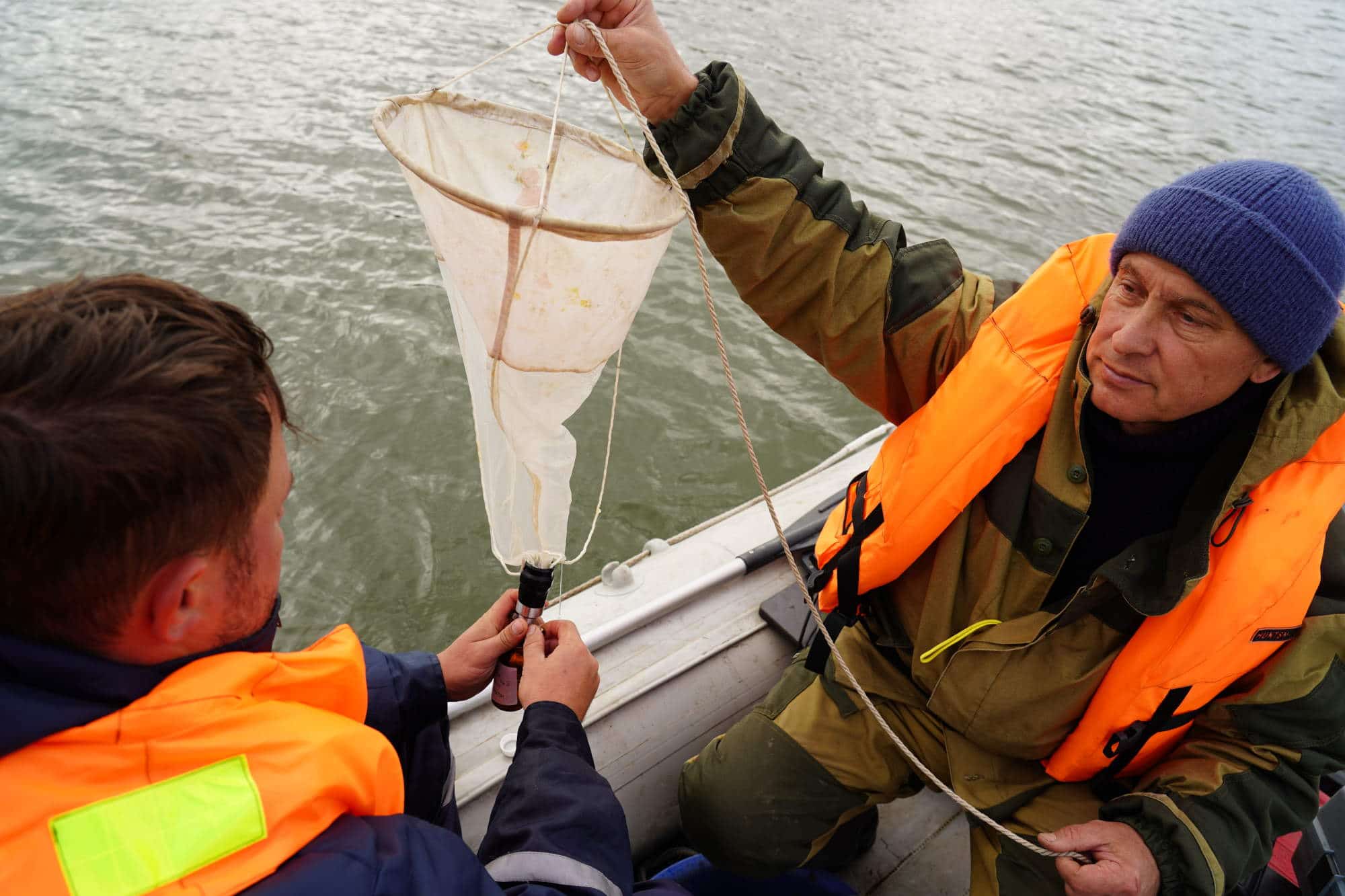
As nations and businesses focus more intently on a global energy transition, new pressures for change are building on Norilsk Nickel from the outside.
Electric vehicle batteries are a major growth opportunity for the company. The most common EV battery type — lithium ion — actually contains more nickel than lithium, because nickel provides great energy density and storage capacity. Demand is expected to increase five-fold to 10-fold within a decade, BloombergNEF projects. Only a few places have the sulfur-rich ore that readily yields the very pure grade Class 1 nickel needed, and the world’s No. 1 producer is Norilsk Nickel.
But selling in the EV market is far different than selling to steel producers, who have been the primary customers for nickel in the past.
Elon Musk, chief executive of the world’s largest EV company, has been vocal about the problems of unsustainable nickel production. “Tesla will give you a giant contract for a long period of time if you mine nickel efficiently and in an environmentally sensitive way,” said Musk at a company earnings call last year.
Potanin has made clear his ambition, announcing that the company will increase production of “green economy” metals 30 percent to 40 percent by 2030. The company’s latest annual report is entitled “Enabling a Transition to a Greener World,” and it says it has a plan to develop “carbon-neutral nickel.” In a September interview with a state-owned TV news channel, Potanin said sustainability had gone from checking off a box to becoming “a deliberate policy of the company, which largely determines the meaning of its existence.”
Norilsk Nickel has said it will spend at least $4.1 billion in a project called Sulfur Program 2.0, to finally tackle the air pollution that has marred the landscape and reduced the quality of life in the Norilsk region. The company has pledged to reduce sulfur dioxide pollution at Norilsk 45 percent by 2023 and 90 percent by 2025.
“Looking for the right technologies and solutions is a hard and long endeavour taking into account the extremely difficult conditions,” wrote the spokesman. “Fortunately, we are finally approaching completion.” Construction has begun, with more than 600 workers involved.
“In my opinion, the implementation of the project will fundamentally change the ecological situation in our city,” said Kasarev, Norilsk’s current mayor. “It will breathe more freely, there will be no emissions, there will be no gas, and our city should breathe a new breath in terms of ecology.
“I would like the Norilsk residents to see what is happening here,” Karasev wrote. “In full, the company is open in terms of showing the project is being implemented, and this is not just talk. We have already seen it with our own eyes.”
Shvarts, who helped Norilsk Nickel develop its new environmental and climate strategy, said he is also hopeful and supports the company striving to be part of the green economy. “I am not very naive, and I do not always trust words,” he said. “Every day, I’m thinking, is it good enough? We need to make every week, every month a few new steps ahead to be a more transparent, more open, more environmentally responsible company.”
Klyushin, however, will not wait for that day to come. He has vowed to leave Norilsk soon and not return.
He worries about his friend Ryabinin, who has four children and has not had a full-time job since quitting Rosprirodnadzor. Klyushin believes he will not find a job again in Norilsk.
“If it were not for Vasily who started this, who discovered this, they would have avoided responsibility, this is clear,” said Klyushin.
After quitting his job at the Russian environmental protection agency, Ryabinin said he has been working as a freelance photographer and spending time focusing on his children, two of whom like to play hockey. He would like to take them to a place where there is more support for sports and more opportunity — and, of course, less pollution. But for now the family has no plans to move. His wife still works for Norilsk Nickel.
The experience of fighting the company changed him, Ryabinin said. “I had an exclusively state mentality, now I think on a global scale, I see economic and political signs of what is happening to our planet,” he said. The problem, he said, is not one company, but consumption without any thought of where the raw material comes from or the need to use less.
“Until the bulk of the population of our planet comes to understand the reasonable consumption of any resources,” he said, “we will not achieve either economic growth or an environmentally friendly planet. We just simply kill our children and leave them a trash heap.” As Ryabinin sees it, Norilsk Nickel is just one of the many examples in the world that demonstrate that truth.
Marianne Lavelle reports for Inside Climate News.
Ludmila Mekertycheva in Moscow contributed to this report.
The Fifth Crime is an ongoing series, produced in collaboration with Inside Climate News and NBC, about the campaign to make “ecocide” an international crime. See other installments here.










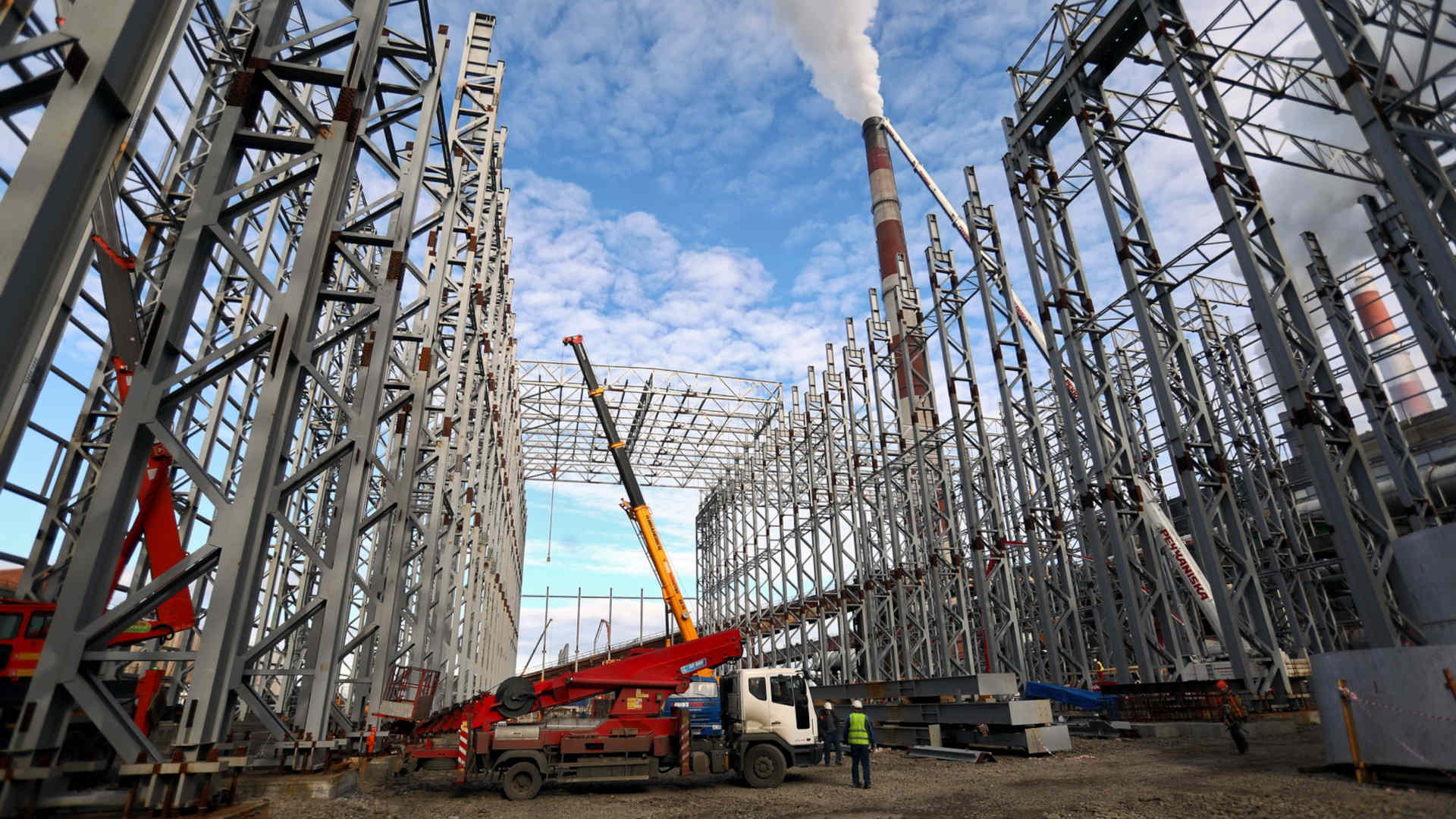
Comments are automatically closed one year after article publication. Archived comments are below.
Wow, what a story! Thanks for the thorough reporting. I’m from China and have seen many rural or remote areas turn into land of death due to industrial pollution, and heard stories of ‘cancer villages’ due to nearby factories or mountains of plastic bottles, which were imported from around the world for ‘recycling’. It is getting harder and harder to have hope for the future
Nuclear power lasts at least 4 times as long, or even far longer and use sthe same sort of steam turbines as all other plants-.
Nuclear can be built quickly and can be made to imitate our best plants. It is safer than any other energy production-including solar-
Of course-we could all move back into caves and wear grass skirts, even as the ice melts and we begin to drown or be parboiled.
So called Fusion power will not be ready to be used for decades-if ever. Big oil/coal, and gas want Democrats and others to believe in fusion-but it will not be here in time to save a single hundredth of a degree in global warming. Nuclear fission is the only known ,well understood way to go-nor is it dangerous-even in the 3 or 4 meltdowns it has undergone, usually bewcause of poor design and emergency procedures during emergencies.(As at Fukushima where a better electrical systgem and emergency core-coolant system would have prevented any accident at all!
Where would the spent fuel be stored? It would be low-enriched, but still…
As long as stock markets and the desire for profit is number 1 concern in world economies, the environmental damage will continue.
Reduce human population and the need for greed, the Earth will heal itself.